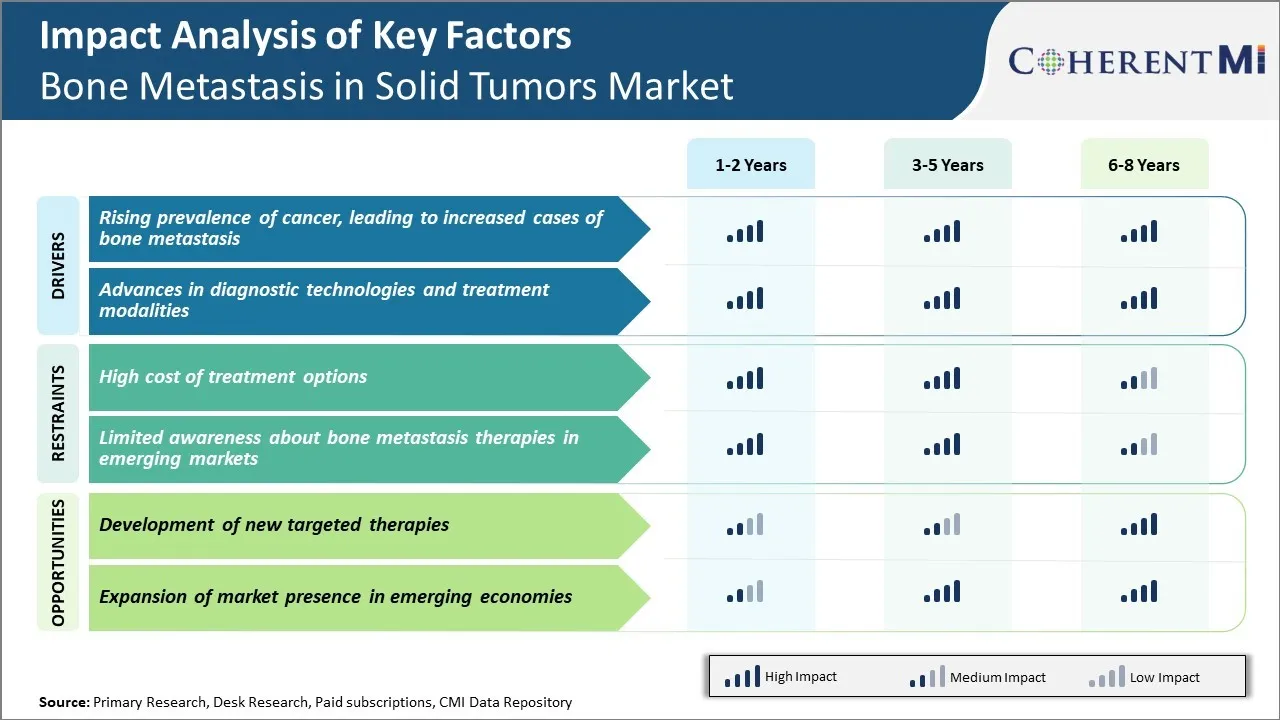Bone Metastasis in Solid Tumors Market Trends
Market Driver - Rising Prevalence of Cancer, Leading to Increased Cases of Bone Metastasis
The increasing occurrence of cancer cases across the globe has led to a proportional rise in bone metastases. Rising obesity levels linked to unhealthy diets and lack of physical activity have major implications for cancers like breast and colorectal which demonstrate skeletal metastatic tendencies.
As bone is one of the most common sites for cancer cells to spread to from primary tumors located elsewhere in the body, a higher prevalence of cancer inevitably translates to greater instances of this deadly phenomenon. While cancers like breast, lung and prostate have long had a strong association with bone metastasis, newer data shows even some less common cancer types demonstrate a propensity to metastasize to the skeleton.
Overall, the compounding effects of an expanding and aging demographic profile coupled with surrounding societal trends mean primary cancer diagnoses will keep mounting. Due to the nature of this disease wherein cells can spread from the initial tumor site, even cancers with historically lower bone metastasis potentials may manifest this complication in greater frequency going forward among larger patient pools. With bones representing such a common secondary site, it is intuitive that bone metastasis case volumes must also rise proportionately.
Market Driver - Advances in Diagnostic Technologies and Treatment Modalities
Significant progress has been made in developing highly sensitive and specific methods to detect the presence as well as extent of bone metastases. Advanced imaging technologies like PET scans and whole-body MRI enable earlier and more accurate identification of sites involved compared to traditional modalities. Likewise, newer biomarker tests are improving abilities to monitor disease progression or recurrence in a minimally invasive manner.
Modern systemic therapies are also offering expanded options for interfering with the pathobiology of bone metastases. Improved variants of bisphosphonates and RANK ligand inhibitors offer enhanced skeletal protection against complications. Additionally, a diverse portfolio of molecularly-targeted drugs, immunotherapies and other novel agents provide opportunities to not just palliate pain but also potentially restrict further tumor growth and spread.
Alongside pharmacological interventions, minimally invasive image-guided techniques enable targeted treatment delivery. Options include radiotherapy, cryotherapy, vertebroplasty and kyphoplasty.
With continuing therapeutic refinement as well as expanding clinical experience, bone metastasis management protocols are becoming increasingly optimized. This stimulates demand for the various diagnostic tools, medications, and procedures applicable across the disease continuum from early identification to long-term management. Their cumulative impact drives growth of the overall bone metastasis in solid tumors market.

Market Challenge - High Cost of Treatment Options
The bone metastasis in solid tumors market faces significant challenges in the high cost of treatment options available. Current treatment approaches such as chemotherapy, radiation therapy, and supportive therapies like pain management medications often require long-term usage to effectively manage the complex symptoms of bone metastases. This long-term treatment burden leads to substantial costs not only for healthcare systems and payers but also out-of-pocket costs for patients.
The advanced staged nature of metastatic bone cancers also means that patients have generally exhausted initial line therapies worsening their condition and increasing treatment costs. Additionally, the lack of curative options necessitates palliative care and supportive treatments over extended periods driving up costs.
Furthermore, many bone metastasis patients are elderly who are often on fixed incomes, making it difficult for them to afford high treatment expenses. The high barrier to access effective therapies poses a major barrier to quality of life and clinical outcomes for bone metastasis patients.
Market Opportunity - Development of New Targeted Therapies
The ongoing active research and development of new targeted therapies represents a major opportunity to drive advances in the bone metastasis in solid tumors market. Recent improvements in understanding the molecular mechanisms underlying bone metastases have opened doors for more precisely targeting key pathways and processes involved.
Several biopharmaceutical companies are conducting clinical trials for novel targeted agents aimed at proteins like DLL4, NRP2, PD-1, and TGF-β among others that play roles in the formation of bone metastases. The successful development of effective and well-tolerated targeted therapies can transform treatment approaches by delivering superior outcomes compared to traditional options like chemotherapy.
New targeted options also promise more affordable and personalized treatment paradigms as precise molecular profiling help match the right patients to the most suitable targeted agents. This will go a long way in addressing the current market challenge of high costs of care. Moreover, targeted therapies are anticipated to demonstrate improved safety profiles over conventional cytotoxic drugs, enhancing patient quality of life.